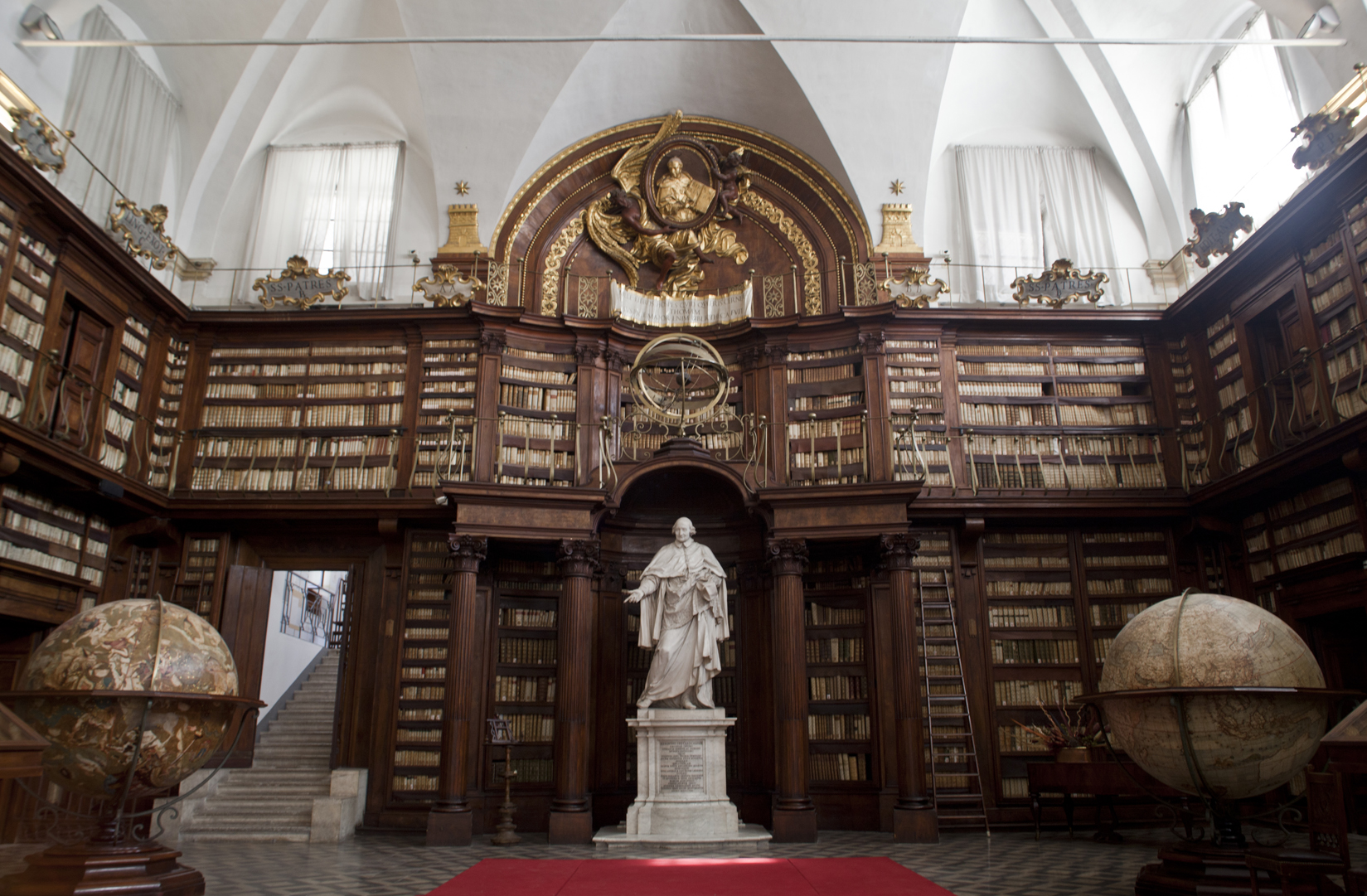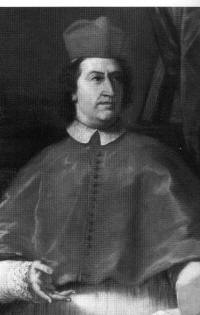|
Biblioteca Casanatense
The Biblioteca Casanatense is a large historic library in Rome, Italy, named in honour of Cardinal Girolamo Casanate (1620–1700) whose private library is at its roots. History The library was established in 1701 by Antonin Cloche, the Master of the Dominicans, at their Convent of Santa Maria sopra Minerva in Rome to house the library left to them by Casanate, containing about 25,000 volumes. Casanate also left an endowment of 80,000 scudi to provide for the administration of the trust and for the acquisition of new books but not for a building. This was erected using a previous inheritance of 1655 of the library of Giambattista Castellani, chief physician of Gregory XV, together with 12,000 scudi for building a suitable edifice. One of the notable 18th century bibliographers of the library was Giovanni Battista Audiffredi. According to Casanate's will, the new library should be accessible to the public six hours daily, apart from feast-days. In addition to the library ... [...More Info...] [...Related Items...] OR: [Wikipedia] [Google] [Baidu] |
Putto
A putto (; plural putti ) is a figure in a work of art depicted as a chubby male child, usually naked and very often winged. Originally limited to profane passions in symbolism,Dempsey, Charles. ''Inventing the Renaissance Putto''. University of North Carolina Press, Chapel Hill and London, 2001. the putto came to represent a sort of baby angel in religious art, often called a cherub (plural cherubim), though in traditional Christian theology a cherub is actually one of the most senior types of angel. The same figures were also seen in representations of classical myth, and increasingly in general decorative art. In Baroque art the putto came to represent the omnipresence of God. A putto representing a cupid is also called an amorino (plural amorini) or amoretto (plural amoretti). Etymology The more commonly found form ''putti'' is the plural of the Italian word ''putto''. The Italian word comes from the Latin word ''putus'', meaning "boy" or "child". Today, in Italian, ... [...More Info...] [...Related Items...] OR: [Wikipedia] [Google] [Baidu] |
Rome R
Rome (Italian language, Italian and , ) is the capital city and most populated (municipality) of Italy. It is also the administrative centre of the Lazio Regions of Italy, region and of the Metropolitan City of Rome. A special named with 2,746,984 residents in , Rome is the list of cities in the European Union by population within city limits, third most populous city in the European Union by population within city limits. The Metropolitan City of Rome Capital, with a population of 4,223,885 residents, is the most populous metropolitan cities of Italy, metropolitan city in Italy. Rome metropolitan area, Its metropolitan area is the third-most populous within Italy. Rome is located in the central-western portion of the Italian Peninsula, within Lazio (Latium), along the shores of the Tiber Valley. Vatican City (the smallest country in the world and headquarters of the worldwide Catholic Church under the governance of the Holy See) is an independent country inside the city boun ... [...More Info...] [...Related Items...] OR: [Wikipedia] [Google] [Baidu] |
Libraries Established In 1701
A library is a collection of books, and possibly other materials and media, that is accessible for use by its members and members of allied institutions. Libraries provide physical (hard copies) or digital (soft copies) materials, and may be a physical location, a virtual space, or both. A library's collection normally includes printed materials which may be borrowed, and usually also includes a reference section of publications which may only be utilized inside the premises. Resources such as commercial releases of films, television programmes, other video recordings, radio, music and audio recordings may be available in many formats. These include DVDs, Blu-rays, CDs, cassettes, or other applicable formats such as microform. They may also provide access to information, music or other content held on bibliographic databases. In addition, some libraries offer creation stations for makers which offer access to a 3D printing station with a 3D scanner. Libraries can vary widely ... [...More Info...] [...Related Items...] OR: [Wikipedia] [Google] [Baidu] |
Minuscule 395
Minuscule 395 (in the Gregory-Aland numbering), ε 216 ( Soden), is a Greek minuscule manuscript of the New Testament, on parchment. Paleographically it has been assigned to the 12th century. It contains marginalia. Description The codex contains the text of the four Gospels on 170 parchment leaves (). The text is written in two columns per page, in 25 lines per page. The text of John 1:19-25 was supplied by a later hand in the 18th century. The text is divided according to the (''chapters''), whose numbers are given at the margin, and their (''titles'') at the top of the pages. There is also a division according to the Ammonian Sections (in Mark 234 Sections, 16:9), with references to the Eusebian Canons (written below Ammonian Section numbers). It contains the tables of the (''tables of contents'') before each Gospel, pictures, and marginal corrections. It is a palimpsest. The text of minuscule 395 is the upper text of the palimpsest. The lower text is unidentified, w ... [...More Info...] [...Related Items...] OR: [Wikipedia] [Google] [Baidu] |
Samaritan
Samaritans (; ; ; ), are an ethnoreligious group originating from the Hebrews and Israelites of the ancient Near East. They are indigenous to Samaria, a historical region of History of ancient Israel and Judah, ancient Israel and Judah that comprises the northern half of what is the West Bank in Palestine. They are adherents of Samaritanism, an Abrahamic religions, Abrahamic, monotheistic, and ethnic religion that developed alongside Judaism. According to their tradition, the Samaritans are descended from the Israelites who, unlike the Ten Lost Tribes of the Twelve Tribes of Israel, were not subject to the Assyrian captivity after the northern Kingdom of Israel (Samaria), Kingdom of Israel was destroyed and annexed by the Neo-Assyrian Empire around 720 BCE. Regarding the Samaritan Pentateuch as the unaltered Torah, the Samaritans view the Jews as close relatives but claim that Judaism fundamentally alters the original Yahwism, Israelite religion. The most notable theological ... [...More Info...] [...Related Items...] OR: [Wikipedia] [Google] [Baidu] |
Codex
The codex (: codices ) was the historical ancestor format of the modern book. Technically, the vast majority of modern books use the codex format of a stack of pages bound at one edge, along the side of the text. But the term ''codex'' is now reserved for older manuscript books, which mostly used sheets of vellum, parchment, or papyrus, rather than paper. By convention, the term is also used for any Aztec codex (although the earlier examples do not actually use the codex format), Maya codices and other pre-Columbian manuscripts. Library practices have led to many European manuscripts having "codex" as part of their usual name, as with the Codex Gigas, while most do not. Modern books are divided into paperback (or softback) and those bound with stiff boards, called hardbacks. Elaborate historical bindings are called treasure bindings. At least in the Western world, the main alternative to the paged codex format for a long document was the continuous scroll, which was the ... [...More Info...] [...Related Items...] OR: [Wikipedia] [Google] [Baidu] |
Lorenzo Alessandro Zaccagni
Lorenzo Alessandro Zaccagni (1652 -1712) was an Italian librarian, and Patristic scholar and author. His main contribution is a collection of texts relating to early controversies in Christianity, ''Collectanea monumentorum veterum Ecclesiæ græcæ et latinæ'', published by the Vatican in 1698 with the approval of the Congregation of Propaganda Fide. Biography Born in Rome to a Florentine family, he studied classics and became a scholar of Greek and Latin in Rome. He came under the patronage first of Cardinal Girolamo Casanatta and then of Cardinal Henry Noris. Cardinal Casanate had been named Bibliotecario di Santa Romana Chiesa (Librarian of the Vatican) and had directed various congregations for the Pope, including the Offices of the Inquisition. Henry Noris was made assistant librarian in the Vatican by Pope Innocent XII. In 1700, on the death of Cardinal Casanate, Noris was given full charge of the Vatican Library. Both fostered the work of Zaccagni, which would have been ... [...More Info...] [...Related Items...] OR: [Wikipedia] [Google] [Baidu] |
Clement XI
Pope Clement XI (; ; ; 23 July 1649 – 19 March 1721), born Giovanni Francesco Albani, was head of the Catholic Church and ruler of the Papal States from 23 November 1700 to his death in March 1721. Clement XI was a patron of the arts and of science. He was also a great benefactor of the Vatican Library; his interest in archaeology is credited with saving much of Rome's antiquity. He authorized expeditions which succeeded in rediscovering various ancient Christian writings and authorized excavations of the Roman catacombs. Biography Early life Giovanni Francesco Albani was born in 1649 in Urbino to the Albani family, a distinguished family of Albanian origin in central Italy. His mother Elena Mosca (1630–1698) was a high-standing Italian of bergamasque origin, descended from the noble Mosca family of Pesaro. His father Carlo Albani (1623–1684) was a patrician. His mother descended in part from the Staccoli family, who were patricians of Urbino, in part from the Gior ... [...More Info...] [...Related Items...] OR: [Wikipedia] [Google] [Baidu] |
Incunabula
An incunable or incunabulum (: incunables or incunabula, respectively) is a book, pamphlet, or broadside (printing), broadside that was printed in the earliest stages of printing in Europe, up to the year 1500. The specific date is essentially arbitrary, but the number of printed book editions exploded in the following century, so that all incunabula, produced before the printing press became Global spread of the printing press#Europe, widespread in Europe, are rare, where even some early 16th-century books are relatively common. They are distinct from manuscripts, which are documents written by hand. Some authorities on the history of printing include block books from the same time period as incunabula, whereas others limit the term to works printed using movable type. there are about 30,000 distinct incunable Edition (book), editions known. The probable number of surviving individual copies is much higher, estimated at 125,000 in Germany alone. Through statistical analy ... [...More Info...] [...Related Items...] OR: [Wikipedia] [Google] [Baidu] |






